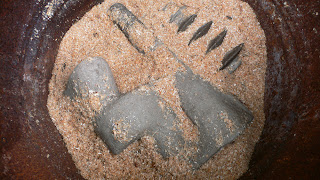Having chosen the name for my work, out of personal vanity yesterday I typed Internal Tourist to the web, and came up with this definition on a popular dictionary website:
Internal tourism means traveling within one's own country.
Searching for a decided-upon title online can bring welcome reassurance, or unexpected surprises. In my case, I seem to have named my dungmix molds after a rather pedestrian definition of interstate travel. I began to wonder if there wasn’t something more interesting about that term; what of the inward-looking and the microscopic? What if internal did not mean the next city across, or my neighbour, but the syncopated organs and vessels that silently operate the organism known as Tom? What if internal tourism was a guided tour of your own mind? Or of the complex elevated routes made by a lifetime living in the branches of trees by Cosimo in Italo Calvino’s Baron in the Trees? To me these present a more colourful and less ordinary picture than the definition I found would suggest.
The kiln is now in its third and final burnout, and having once again started it from the previous ashes, I’d affirm that it has been going non-stop for a grand total of 150 hours since its first damp inception.
To avert my attention from building steel stands for the molds (of which one is definitely suffering from structural weakness. I’ve come to realise that my 15% of clay in the mix should have been around 20%. Therefore all the molds are now a little crumbly despite being fairly well fired), we had a bronze pour today. I had previously decided that although none of the main body of work was to have metal poured inside (it would simply pour straight back out even if I tried!), I’d build one dung mold that was to be cast. The object within is something of a personal secret, and can only be identified as Law.
Ceramic shell and dungmix shell. What will happen?
The day went very well. While Gordon and his brother worked on their Aberdeen coats of arms, I re-jigged and re-welded the burnout kiln (a different one) to a workable standard, then Katie could begin to heat the molds to remove the wax. Eden fired up the furnace, and began the process of pre-heating odd fragments of bronze before dropping them into the inferno. Among today’s offerings were the bronze tooth of a great white shark, the cranking lever from one of the Wright Brother’s early flying machines, switchgear from the control room of Hunterston B power station, and a series of small bronze meteorites found at the peak of Tap O’ Noth last week. All were flung in and melted down, ready to lead new unwritten destinies as sculptural artifact.
Suddenly the fans stopped, leather aprons were donned, and an apprehensive silence meant the pour was to take place. I was to pour, Eden to guide and Katie to skim. This was my first time being the one in charge of the crucible, and I was careful not to go wrong. Within two minutes, the intense red-orange liquid flowed and the molds filled. My dungmix held for a few seconds before the cup popped. Luckily we had encased the majority of the mold in a bucket of foundry oil sand, and this saved the mold proper. I came away full of excitable energy, and an impatient desire to break it open straight away. Finally, an hour later I did, and found that while ceramic shell gives great surface detail, the organic particles in horse dung give a spidery, rough quality to the cast. Law was a successful cast in a home-grown sort of way, and a good way to test what is after all a casting material.
Unfortunately no photos exist of this historic occasion, because my camera ran out of memory. Instead, here’s a photo of Gordon’s aluminium pour:





























